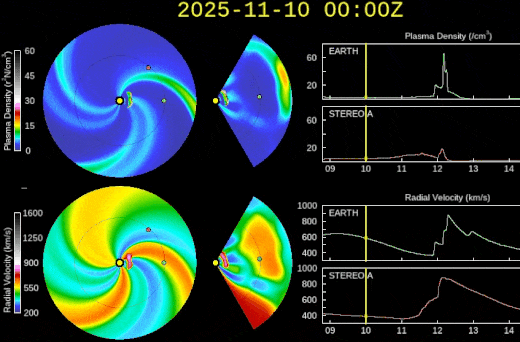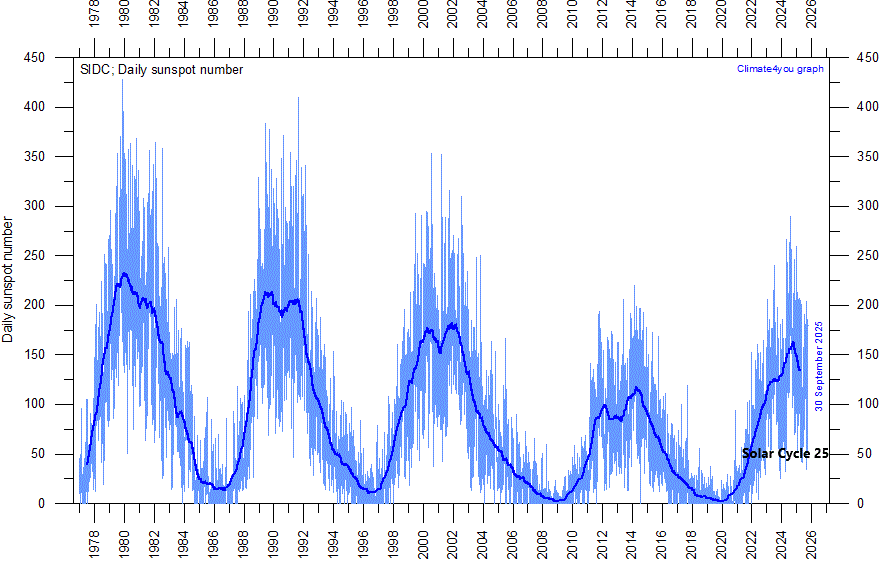***Sun unleashes most powerful solar flare of 2025...today's burst follows two intense flares on Sunday and Monday...all three flares produced coronal mass ejections...watch for auroras***
Paul Dorian
AR4274 featured two intense solar flares in recent days - both associated with coronal mass ejections (CMEs) - and NOAA’s forecast model suggests they may combine into a so-called “cannibal CME” before reaching the Earth as early as later tonight. Courtesy NOAA
Overview
Solar cycle 25 is in its maximum phase as we approach the end of the year and it has featured numerous active sunspot regions in recent weeks. In fact, one such sunspot region known officially as AR4274 had an X5.1 class eruption early Tuesday morning...the year’s most powerful solar flare...and this follows two intense flares from the same sunspot region that took place on Sunday and Monday. The latest data that has come in on this morning’s intense solar flare suggests it was indeed accompanied by a coronal mass ejection (CME) that could reach the Earth on Wednesday, November 12th. Meanwhile, the prior two flares - which were also accompanied by coronal mass ejections - may combine into a “cannibal” CME before reaching Earth as early as later tonight.
Sunspot region known officially as AR4274 erupted early Tuesday with a major X5.1 class solar flare. This eruption took place around 5:10 AM (ET) on Tuesday and follows a couple of other intense flares during the past couple of days from this same sunspot region. Map courtesy NOAA/SWPC
Details
The sun erupted on Tuesday morning, November 11th, unleashing a major X5.1 class solar flare...the strongest of the year so far, one of the strongest of solar cycle 25, and the most intense in over a year since October 2024. The eruption began at around 5:10 AM (ET) from sunspot AR4274 which has been very active in recent days and the very latest data suggests it was indeed accompanied by a coronal mass ejection. This latest blast caused a deep shortwave radio blackout over southern Africa, and its CME could impact Earth on Wednesday and, according to spaceweather.com, potentially adding itself to the “cannibal” CME described above.
Solar cycle 25 is likely in its maximum phase as we close out the year of 2025, and there have been numerous active sunspot regions in recent weeks. Solar cycle 25 began in late 2019/early 2020 and has featured no “spotless” days since 2022. Map courtesy NOAA, climate4you.com
Today’s outburst is the latest in a series of intense solar flares from AR4274 which also produced an X1.7 flare on Sunday, November 9th, and an X1.2 flare on Monday, November 10th. It is possible that those two flares which were accompanied by coronal mass ejections (CMEs) could combine into a so-called “cannibal” CME and impact the Earth as early as later tonight, possibly triggering geomagnetic storms and widespread auroras according to NOAA’s Space Weather Prediction Center. “Cannibal” CMEs contain shock waves and enhanced magnetic fields that do a good job sparking and amplifying geomagnetic storms. The last time a “cannibal” CME hit was on April 15, 2025 and it caused a severe G4-class storm with auroras sighted as far south as France.
Solar flares are ranked by strength in five classes, A, B, C, M and X, with each step representing a tenfold increase in energy output. X-class solar flares are the most powerful kind and the number following the X describes the flare's intensity. At X5.1, this latest eruption sits toward the top of the scale. This active sunspot region has become one of the most prolific solar flare producers of Solar Cycle 25, marking a fiery peak in what's already been an extraordinary week for solar activity.
Bottom line…sky watchers should be alert for auroras during the next couple of nights.
Meteorologist Paul Dorian
Arcfield
arcfieldweather.com



